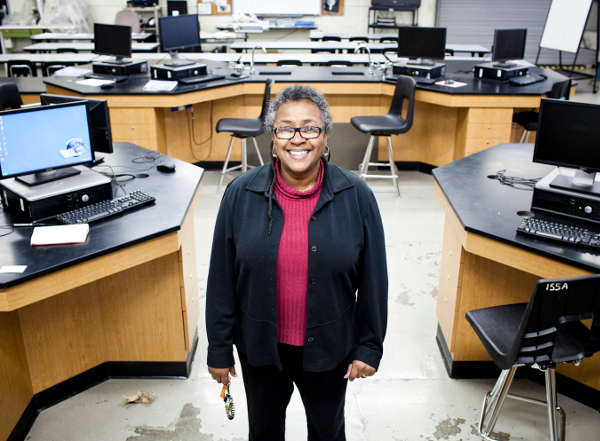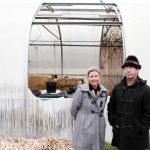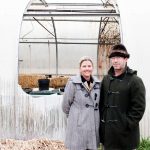Ms Campbell’s Earth Science classroom in McClain Junior/Senior Magnet High School looks huge and spotless without the students in it. They’ve gone home for the day. The tools of the modern high school science lab are everywhere: gas outlets and computers on the wide, black desks, microscopes in back, the chemical shower for emergencies. Ms Campbell uses all this to teach her courses, but one of the best parts of her curriculum is in the garden and greenhouse just outside the school’s walls. That’s where the students can get their hands dirty, breathe fresh air while learning, even go find relief and escape from the realities of north Tulsa’s harsh neighborhoods.
Behind the McClain building, tucked into a nook of the school and the parking lot, an old greenhouse had sat dormant, overgrown, and near-collapse for years. By 2009, a community organizer named Steve Eberly had begun a sweeping healthy food initiative across Tulsa and especially north Tulsa. His program (recipient of the USDA’s Community Food Project (CFP) grant), called Food for Life, had the goal of affecting positive change in what Eberly called a “three-prong approach.” The three prongs were the basic tenets of many food security initiatives: improve knowledge of healthy foods through cooking and nutrition education outreach for adults and children, establish and maintain community gardens, and encourage better food policy on a local and state-wide level.
So Eberly embarked on a fervent mission through north Tulsa, installing dozens of community gardens and raised beds, pushing, with other community members and organizations (including Demalda Newsome’s son Chris Newsome – see the Newsome Community Farms profile) for Representative Seneca Scott to sponsor a bill that would secure agricultural funds for a healthy corner store initiative. He led the charge to create the Tulsa Food Security Council. His group organized North Tulsa Eats, a community dinner open, free of charge, to all of North Tulsa. Owners and cooks from the soul food restaurants that dominate the neighborhood volunteered their time and worked with Eberly and others to make small, healthful changes to their dishes. Residents gathered in the McClain High School gymnasium for a shared meal and a chance to see healthy food, culturally appropriate food options.
 Eberly’s ambitious, “shotgun” approach intended to spread as much seed for change as possible. Some of the gardens and raised beds failed, either due to poor training of the immediate residents, misguided placement within the community, or, it could be argued, a lack of cultural literacy. Going into a foreign community with an outside idea of what’s best for those people has its obvious pitfalls. And with Eberly’s broad-sweeping approach, some gardens weren’t completely seen through. But many of the gardens stuck and many children, as Eberly and Food for Life hoped, began to see for the first time where real food comes from.
Eberly’s ambitious, “shotgun” approach intended to spread as much seed for change as possible. Some of the gardens and raised beds failed, either due to poor training of the immediate residents, misguided placement within the community, or, it could be argued, a lack of cultural literacy. Going into a foreign community with an outside idea of what’s best for those people has its obvious pitfalls. And with Eberly’s broad-sweeping approach, some gardens weren’t completely seen through. But many of the gardens stuck and many children, as Eberly and Food for Life hoped, began to see for the first time where real food comes from.
North Tulsa has a life expectancy rate fourteen years younger than the rest of Tulsa. The city is as segregated racially and economically as any in the country. Bringing different groups together around food, from ground-level growing to legislative policy changes, is a monumental effort in uncharted waters. Eberly’s passion for change and for action generated a lot of momentum in a short time.
Unfortunately, Eberly passed away from brain disease in August of 2011. The grant had over a year left and things were just getting ramped up. The McClain greenhouse project had been completed with help from Ms. Campbell’s and other classes’ students. A Greenhouse Council was set up to maintain it. The Tulsa Food Security Council of over 30 community organizations had coalesced and found a pivotal awareness cause in the Buy Fresh, Buy Local marketing campaign to connect consumers to farmers and farmers markets. And North Tulsa Eats had become an annual event, attended by hundreds of residents. The three prongs were taking root.
So when Eberly passed away, he left a powerful wave of energy and conversation among organizations and individuals fighting for the same food security balance throughout Tulsa. Fortunately, Eberly’s passion was somewhat contagious and many Tulsans caught it. Katie Plohocky was in commercial real estate until she found herself becoming increasingly involved in the community grassroots efforts around healthy food. Her husband, Scott Smith, was a community organizer and entrepreneur. He’d opened the Blue Jackalope in downtown as an alternative grocery store with healthy, affordable options and local produce. But its small scale limited access to the large-scale distribution center, meaning the Blue Jackalope couldn’t get the products it needed at the price that made sense for the neighborhood. So Scott had to close it.
But Katie, and Scott to an extent, took over the reigns from their close friend Eberly. Katie now heads up the Tulsa Food Security Council. She and Scott are using lessons learned from the Blue Jackalope experience to reorganize the way farmers and distribution centers relate. They want to encourage farmers to increase their produce yields so they can sell to the distributors and they want to then be able to buy local produce for use in the Healthy Corner Store Initiative. The program is approved to run, it just needs to figure out the logistics of payment and distribution.
It is naive to link a movement, even a small one like that of community gardens and healthy food in North Tulsa, to a single person. That happens often with Eberly and it unfortunately omits the equally dedicated work of dozens of others, including other CFP recipients. But Eberly had a profound impact on a wide scale by literally sowing thousands of seeds and figuratively cross-pollinating the all-too-divisive class and race boundaries of Tulsa.
Each year new families and returning families walk into the rich smells of the McClain gymnasium to share a healthy version of a home-cooked meal. The menus in local restaurants shift ever so slightly toward more nutritious options. And a new class of students learn about the power of getting their hands dirty and watching something grow in the greenhouse behind Ms Campbell’s classroom.






